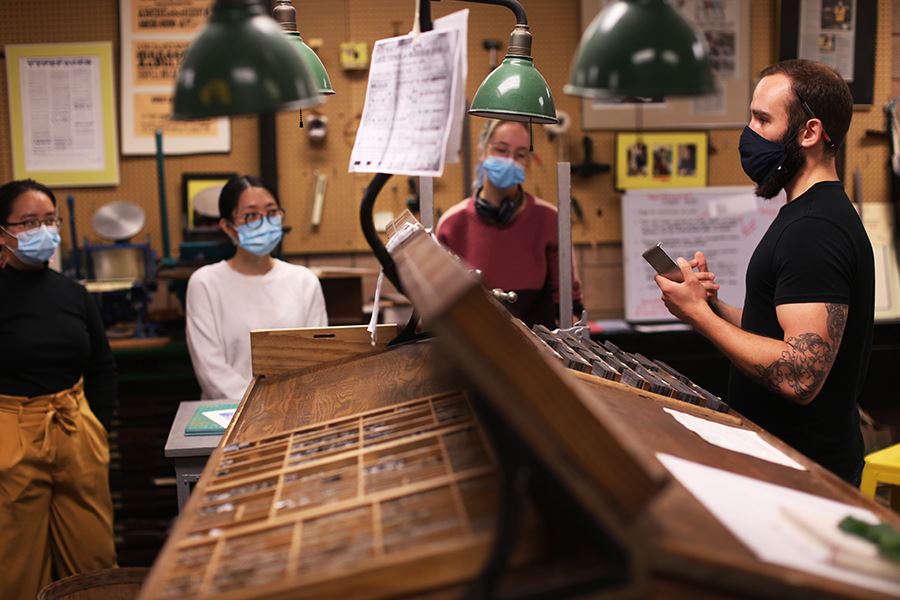Clive Phillpot, former head of the library at the Museum of Modern Art, loosely defines artists’ books as: “distinguished by the fact that they sit provocatively at the juncture where art, documentation, and literature all come together…. What really characterizes artists’ books is that they reflect and emerge from the preoccupations and sensibilities of artists, as makers and as citizens”[1].

Kyle Clark teaching students the fundamentals of letterpress and pressure printing at the University of Michigan Library’s Book Arts Studio. Photo by Alan J. Piñon, director of Communication & Marketing at the University of Michigan Library.
“[A]t the juncture where art, documentation, and literature all come together”[1], libraries have and continue to be defined as centers for learning and growth that extend beyond the covers of the Book, or traditional information media. To many, the integration of creative tools within library resources encourages creative freedom and more engaged forms of learning and growth. Book arts studio environments, encompassing a variety of book arts related tools and resources (i.e. letterpress printing, print media, bookbinding, hand papermaking, calligraphy, etc.), have emerged in several college and university library settings within the United States as places that facilitate creative research opportunities and engaged forms of learning. These book arts studio environments provide students and researchers with an opportunity to make critical connections through artistic and scholarly processes while also allowing these library patrons to produce creative work (artists’ books, prints, book art objects, etc.) as both research process and product through varied arts-based inquiry and research methodologies.[2] In a college or university library setting (or a public library setting) this mode of creative engagement lends itself well to providing opportunities for collaboration across disciplines, academic departments, and external communities.
Among the American colleges and universities with library embedded book arts studio environments are institutions such as Wellesley College, Dartmouth College, University of Richmond, University of Michigan, University of Pennsylvania, Oberlin College, University of Utah, Colorado College, and several others. Each of the college and university libraries that host book arts studio, workshop, or laboratory spaces have a common grounding in their relationship to libraries as hubs for information, research, scholarship, and creative output. It is relevant to note that a few of the above-mentioned library-based book arts environments incorporate small press models for artist book and fine press publishing (i.e., those at Colorado College and the University of Utah).[3] The small press model within library settings, separate from academic departments, creates an environment where free expression can take place, transcending academic and artistic disciplines.
In an effort to better understand the place of the book arts in current college and university libraries, I was fortunate to have been able to have conversations with the directors at three of the above-mentioned book arts environments: Katherine Ruffin, director of the Book Arts Lab at Wellesley College; Jen Thomas, director of the Book Arts Studio at the University of Richmond; and Sarah Smith, director of the Library Book Arts Workshop at Dartmouth College. Each of these programs is unique, serving their home institution through a combination of book arts programming. Such types of programs include: course instruction/instructional support, non-academic workshops in the book arts, and in some instances providing open studio times for students and library patrons to work on class or independent book arts projects. One of the main commonalities of note within the library-based book arts programs of Dartmouth College, Wellesley College, and the University of Richmond is their collaboration with faculty (from a wide range of disciplines) in order to provide instructional sessions through their respective book arts environments. This type of engagement allows students to explore topics and themes from their coursework through the lens of book arts production, including through the production of artists’ books, prints, zines, and related book arts objects. Sometimes elements of book history or the study of the book as material objects are incorporated into these instructional sessions, as was described by Katherine Ruffin of Wellesley College.[4] In other instances, the book arts serve as a tool or methodology for critically examining complex areas of study. The latter was described by Jen Thomas at the University of Richmond in which a group of students from the University and local HIV community members explore and record narratives through the creation of artists’ books.[5]
For the next Book Art Theory blog post I’ve written short vignettes highlighting the library-based book arts programs at Dartmouth College, Wellesley College, and the University of Richmond based on conversations with the directors of those three programs. Within these brief overviews, I have attempted to bring attention to aspects that are unique to each program while describing creative projects and/or the programming central to their operation within academic libraries and higher education.
[1] Lauf, Cornelia, and Clive Phillpot. Artist-Author: Contemporary Artists' Books. 31. New York: Distributed Art Publishers, 1998.
[2] Rolling, James Haywood. “A Paradigm Analysis of Arts-Based Research and Implications for Education.” Studies in Art Education. Routledge, n.d. doi:10.1080/00393541.2010.11518795. If you are unfamiliar with arts-based research methodologies, this is a nice place to start. As an artist practitioner-educator, I find an enormous amount of value in the work that has been written on arts-based research and its implications for creative scholarly communication.
[3] “The Press at CC.” Colorado College, April 1, 2021. https://www.coloradocollege.edu/library/press/. “Red Butte Press.” Red Butte Press - Marriott Library - the University of Utah, January 4, 2020. https://lib.utah.edu/collections/red-butte-press/.
[4] Clark, Kyle, and Ruffin, Katherine. Book arts in college and university libraries. January 7, 2022. Personal interview conducted over Zoom.
[5] Clark, Kyle, and Thomas, Jen. Book arts in college and university libraries. December 16, 2021. Personal interview conducted over Zoom.
Kyle Anthony Clark is an artist and educator living in Ann Arbor, Michigan. Kyle works at the University of Michigan Library’s conservation laboratory and as an instructor in the Book Arts Studio. Kyle maintains an independent practice and teaches courses and workshops on artists’ books, bookbinding, letterpress, and papermaking.

